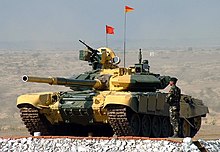Kontakt-5

Kontakt-5 is a type of second-generation[1] explosive reactive armour (ERA) originating in the Soviet Union. It is the first type of ERA which is effectively able to defeat modern armour-piercing fin-stabilized discarding sabot (APFSDS) rounds.
Introduced on the T-80U tank in 1985, Kontakt-5 is made up of "bricks" of explosive sandwiched between two metal plates. The plates are arranged in such a way as to move sideways rapidly when the explosive detonates. This will force an incoming kinetic energy penetrator or shaped charge jet to cut through more armour than the thickness of the plating itself, since "new" plating is constantly fed into the penetrating body. A kinetic energy penetrator will also be subjected to powerful sideways forces, which might be large enough to cut the rod into two or more pieces. This will significantly reduce the penetrating capabilities of the penetrator, since the penetrating force will be dissipated over a larger volume of armour.
Newer KE penetrators like the US M829A3, were "driven by the need to counter KE-effective explosive reactive armor (ERA)".[2]
Relikt was designed by the Russian army in response to the new developments. Relikt is the 3rd generation Russian ERA, and is claimed to be twice[3][4] as effective as Kontakt-5. It can be installed on T-72B and T-90 tanks and adopted in 2006.[5] As of 2013, only the T-72BM 'Rogatka' introduced in 2006 has Relikt ERA.[6] The Russian Army T-72B3M main battle tank incorporates Relikt.[7] Developed by NII Stali, Relikt utilizes a completely new composition of explosives to achieve dynamics protection. Unlike Kontakt-5, it works equally reliably against both low-velocity and high-velocity missiles, doubling protection against shaped charges and increasing anti-tank guided missile protection by 50 percent.[8] Relikt defends against tandem warheads and reduces penetration of APFSDS rounds by over 50 percent.[9]
Kontakt-5 armour is employed by Russia, Ukraine, India (T90-S) and Serbia (on M-84AS MBT), among others.
Ideas have been drawn up for a new type of ERA called Kaktus which has been developed, although it has yet to be deployed.[10]
Malachit - the latest generation (4th) Russian explosive reactive armor. Mounted on Armata project vehicles.
See also
References
- ^ Kontakt-5 ERA
- ^ "M829E3 120mm Armor-Piercing Fin-Stabilized Discarding Sabot- Tracer (APFSDS-T) Cartridge" (PDF).
- ^ http://www.niistali.ru/security/armor/relict?start=1
- ^ http://www.niistali.ru/security/armor/builtincontakt?start=1
- ^ "Archived copy". Archived from the original on November 29, 2014. Retrieved November 15, 2014.
{{cite web}}: Unknown parameter|deadurl=ignored (|url-status=suggested) (help)CS1 maint: archived copy as title (link) - ^ "T-72BM 'Rogatka' & T-72M1 Modernised". Pakistan Defence. Feb 2, 2011. Retrieved April 30, 2014.
- ^ https://ria.ru/arms/20170209/1487602619.html
- ^ Russia to unveil new explosive reactive armour at Nizhniy Tagil arms expo - Topasianews.com, 27 July 2011
- ^ T-90MS Tagil - Military-Today.com
- ^ http://www.fprado.com/armorsite/T-90S.htm
